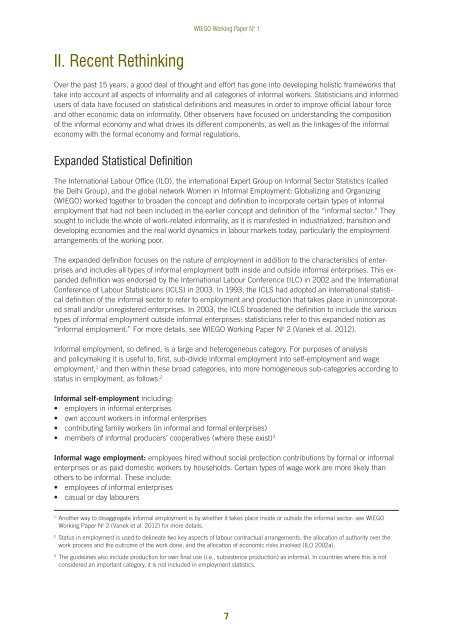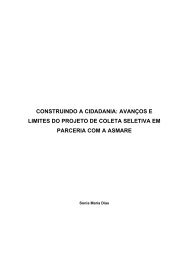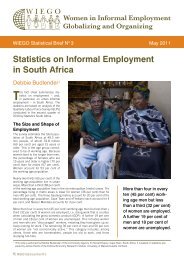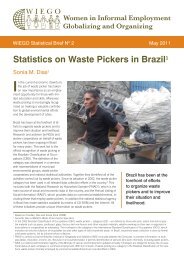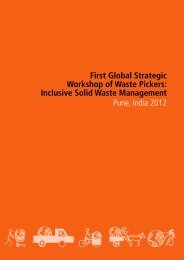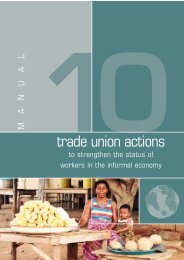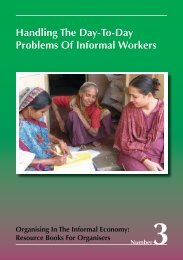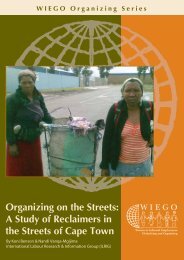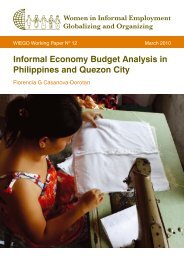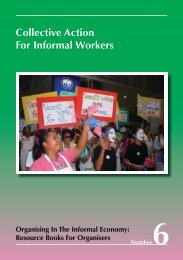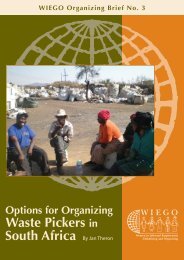The Informal Economy: Definitions, Theories and ... - Inclusive Cities
The Informal Economy: Definitions, Theories and ... - Inclusive Cities
The Informal Economy: Definitions, Theories and ... - Inclusive Cities
Create successful ePaper yourself
Turn your PDF publications into a flip-book with our unique Google optimized e-Paper software.
WIEGO Working Paper N o 1<br />
II. Recent Rethinking<br />
Over the past 15 years, a good deal of thought <strong>and</strong> effort has gone into developing holistic frameworks that<br />
take into account all aspects of informality <strong>and</strong> all categories of informal workers. Statisticians <strong>and</strong> informed<br />
users of data have focused on statistical definitions <strong>and</strong> measures in order to improve official labour force<br />
<strong>and</strong> other economic data on informality. Other observers have focused on underst<strong>and</strong>ing the composition<br />
of the informal economy <strong>and</strong> what drives its different components, as well as the linkages of the informal<br />
economy with the formal economy <strong>and</strong> formal regulations.<br />
Exp<strong>and</strong>ed Statistical Definition<br />
<strong>The</strong> International Labour Office (ILO), the international Expert Group on <strong>Informal</strong> Sector Statistics (called<br />
the Delhi Group), <strong>and</strong> the global network Women in <strong>Informal</strong> Employment: Globalizing <strong>and</strong> Organizing<br />
(WIEGO) worked together to broaden the concept <strong>and</strong> definition to incorporate certain types of informal<br />
employment that had not been included in the earlier concept <strong>and</strong> definition of the “informal sector.” <strong>The</strong>y<br />
sought to include the whole of work-related informality, as it is manifested in industrialized, transition <strong>and</strong><br />
developing economies <strong>and</strong> the real world dynamics in labour markets today, particularly the employment<br />
arrangements of the working poor.<br />
<strong>The</strong> exp<strong>and</strong>ed definition focuses on the nature of employment in addition to the characteristics of enterprises<br />
<strong>and</strong> includes all types of informal employment both inside <strong>and</strong> outside informal enterprises. This exp<strong>and</strong>ed<br />
definition was endorsed by the International Labour Conference (ILC) in 2002 <strong>and</strong> the International<br />
Conference of Labour Statisticians (ICLS) in 2003. In 1993, the ICLS had adopted an international statistical<br />
definition of the informal sector to refer to employment <strong>and</strong> production that takes place in unincorporated<br />
small <strong>and</strong>/or unregistered enterprises. In 2003, the ICLS broadened the definition to include the various<br />
types of informal employment outside informal enterprises: statisticians refer to this exp<strong>and</strong>ed notion as<br />
“informal employment.” For more details, see WIEGO Working Paper N o 2 (Vanek et al. 2012).<br />
<strong>Informal</strong> employment, so defined, is a large <strong>and</strong> heterogeneous category. For purposes of analysis<br />
<strong>and</strong> policymaking it is useful to, first, sub-divide informal employment into self-employment <strong>and</strong> wage<br />
employment, 1 <strong>and</strong> then within these broad categories, into more homogeneous sub-categories according to<br />
status in employment, as follows: 2<br />
<strong>Informal</strong> self-employment including:<br />
• employers in informal enterprises<br />
• own account workers in informal enterprises<br />
• contributing family workers (in informal <strong>and</strong> formal enterprises)<br />
• members of informal producers’ cooperatives (where these exist) 3<br />
<strong>Informal</strong> wage employment: employees hired without social protection contributions by formal or informal<br />
enterprises or as paid domestic workers by households. Certain types of wage work are more likely than<br />
others to be informal. <strong>The</strong>se include:<br />
• employees of informal enterprises<br />
• casual or day labourers<br />
1<br />
Another way to disaggregate informal employment is by whether it takes place inside or outside the informal sector: see WIEGO<br />
Working Paper N o 2 (Vanek et al. 2012) for more details.<br />
2<br />
Status in employment is used to delineate two key aspects of labour contractual arrangements: the allocation of authority over the<br />
work process <strong>and</strong> the outcome of the work done; <strong>and</strong> the allocation of economic risks involved (ILO 2002a).<br />
3<br />
<strong>The</strong> guidelines also include production for own final use (i.e., subsistence production) as informal. In countries where this is not<br />
considered an important category, it is not included in employment statistics.<br />
7


